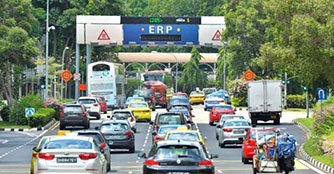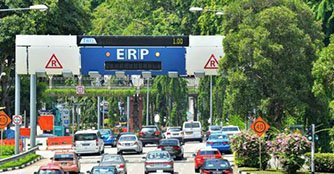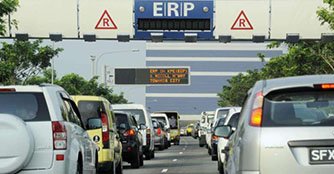Motorists still divided over ERP's success as it turns 20
16 Apr 2018|5,070 views
Motorist Lim Quan An used to take the Kallang-Paya Lebar Expressway to get from his home in Loyang to work in Alexandra. But since Electronic Road Pricing (ERP) gantries on the KPE were turned on last April, the 34-year old compliance specialist has switched to using the East Coast Parkway.
"Traffic is moderate. And I time myself to pass the Keppel exit after 9:00am," he said, referring to the only Electronic Road Pricing gantry along the route, which he passes.
Entrepreneur Tony Tan, 52, also adjusts his routes according to ERP timings. "I do schedule my appointments around the times ERP is activated... I don't like hearing the beep every time money is deducted from the CashCard."
Mr. Lim and Mr. Tan are not alone. A poll that The Straits Times conducted with the Automobile Association of Singapore (AAS) found that the majority of drivers say ERP - which turned 20 this month - influences their travelling patterns significantly.
Among 1,230 AAS members who responded, 77 percent of them chose a ranking of six and above - one being of low influence and 10 of high influence - when asked whether ERP played a part in deciding where and when they drive.
But at the same time, all respondents say that they sometimes find themselves paying for ERP when they do not expect to, with more than one-third (37 percent) saying that this happens often. And most people feel the system is not effective in controlling congestion on the whole, with less than one-third (32 percent) giving it an above-average rating.
When asked to explain the results, AAS Chief Executive Lee Wai Mun said, "The survey results do indicate that people try to adjust their travel patterns, but responses to some questions seem to suggest people who need to drive will still do so. Should we interpret the effectiveness factor as a lack of alternatives? It may be something for our planners to think about."
Singapore University of Social Sciences (SUSS) senior lecturer and transport economist Walter Theseira said, "Obviously, if motorists pay ERP unexpectedly, we can say ERP has no chance to be effective in changing their behaviour." Not unexpectedly, there are many motorists who are sceptical of ERP's effectiveness.
Business consultant Albert Lee, 59, said, "It's squeezing the air from one part of the balloon to another. Basically, it's creating convenience for people who are willing to pay." Retiree Lee Chiu San, 72, said that for ERP to be more effective, there must be real alternatives to driving.
"Before anything else, public transport must be efficient, reliable and available in areas where the Government wants to discourage driving," Mr. Lee said. "When the above condition is fulfilled, pricing can be an effective measure to distribute traffic congestion."
The view that ERP flattens peak demand by spreading usage across different time periods and areas is well accepted. A Land Transport Authority (LTA) spokesman said the system has helped 'by encouraging motorists to consider switching their time of travel, route or mode of transport', even if the number of gantries and amounts charged have increased over the years.
There were some 30 gantries in the first two years, with peak charges for cars set at $2. Today, there are close to 80 gantries, with car charges peaking at $6. The spokesman said the system has kept traffic speeds 'within the optimal range'.
For instance, a daily average of 304,000 vehicles entered the Central Business District (CBD) last year - up 2.2 percent from 2015. Yet, the average speed during peak hours rose by two percent to 30km/h within the CBD and major arterial roads over the same period.
The effect of ERP on expressways, however, has not been as successful over the same period. The average speed on expressways dipped by 2.7 percent to 60.2km/h. The LTA said, however, that this was still within the 'optimal range'.
The LTA said the fact that speeds have remained relatively constant despite a growing vehicle populations shows ERP has been effective. Singapore's vehicle population rose by 0.5 percent to 961,842 between 2015 and last year. But detractors said speeds should have improved more markedly given that road capacity has increased - the LTA was unable to provide the latest figures - and distances clocked by drivers have plunged.
Motorist Vignesh Louis Naidu, 34, a director of operations, said, "I think the system is not particularly effective as the sunk cost of car ownership is very high. If one chooses to purchase a car, one is unlikely to significantly reduce usage because of ERP charges."
Experts, however, reckon that it is difficult to quantify the effectiveness of ERP without a proper before-and-after comparison.
Dr. Theseira of SUSS said, "People have a hard time imagining what our roads would be like without ERP. I believe we tend to systematically underestimate how bad congestion would be without pricing."
Indicating that effectiveness can also be measured in other ways, he added, "The best outcome for ERP is to discourage the most travel in congested areas at the least possible cost both in infrastructure cost and to motorists."
The LTA would not say how much it collects in ERP charges. But back in 2003, ERP revenue averaged $320,000 a day. Will motorists have to pay more when ERP 2.0 - which will be able to charge for distance - arrives in 2020?
Observers said those who clock high mileages - such as taxi drivers, private-hire drivers and deliverymen - will clearly incur higher costs. But motorists in general may not necessarily pay more. Dr. Theseira noted that the new system 'may be able to improve awareness and communication because the in-vehicle unit will have more functions'.
The LTA said real-time, targeted information will be available on the new ERP unit to help motorists better plan their travel routes. The unit will also allow e-payments for parking and checkpoint tolls. The new satellite-based system will be incorporated into the LTA's future traffic management systems. Traffic light timings, for instance, will be able to adjust to real-time road conditions.
The LTA spokesman said this system 'will provide an open platform to enable third-party app developers to tap the existing framework to innovate, and design and develop value-added services that will be of benefit to motorists'.
Motorist Lim Quan An used to take the Kallang-Paya Lebar Expressway to get from his home in Loyang to work in Alexandra. But since Electronic Road Pricing (ERP) gantries on the KPE were turned on last April, the 34-year old compliance specialist has switched to using the East Coast Parkway.
"Traffic is moderate. And I time myself to pass the Keppel exit after 9:00am," he said, referring to the only Electronic Road Pricing gantry along the route, which he passes.
Entrepreneur Tony Tan, 52, also adjusts his routes according to ERP timings. "I do schedule my appointments around the times ERP is activated... I don't like hearing the beep every time money is deducted from the CashCard."
Mr. Lim and Mr. Tan are not alone. A poll that The Straits Times conducted with the Automobile Association of Singapore (AAS) found that the majority of drivers say ERP - which turned 20 this month - influences their travelling patterns significantly.
Among 1,230 AAS members who responded, 77 percent of them chose a ranking of six and above - one being of low influence and 10 of high influence - when asked whether ERP played a part in deciding where and when they drive.
But at the same time, all respondents say that they sometimes find themselves paying for ERP when they do not expect to, with more than one-third (37 percent) saying that this happens often. And most people feel the system is not effective in controlling congestion on the whole, with less than one-third (32 percent) giving it an above-average rating.
When asked to explain the results, AAS Chief Executive Lee Wai Mun said, "The survey results do indicate that people try to adjust their travel patterns, but responses to some questions seem to suggest people who need to drive will still do so. Should we interpret the effectiveness factor as a lack of alternatives? It may be something for our planners to think about."
Singapore University of Social Sciences (SUSS) senior lecturer and transport economist Walter Theseira said, "Obviously, if motorists pay ERP unexpectedly, we can say ERP has no chance to be effective in changing their behaviour." Not unexpectedly, there are many motorists who are sceptical of ERP's effectiveness.
Business consultant Albert Lee, 59, said, "It's squeezing the air from one part of the balloon to another. Basically, it's creating convenience for people who are willing to pay." Retiree Lee Chiu San, 72, said that for ERP to be more effective, there must be real alternatives to driving.
"Before anything else, public transport must be efficient, reliable and available in areas where the Government wants to discourage driving," Mr. Lee said. "When the above condition is fulfilled, pricing can be an effective measure to distribute traffic congestion."
The view that ERP flattens peak demand by spreading usage across different time periods and areas is well accepted. A Land Transport Authority (LTA) spokesman said the system has helped 'by encouraging motorists to consider switching their time of travel, route or mode of transport', even if the number of gantries and amounts charged have increased over the years.
There were some 30 gantries in the first two years, with peak charges for cars set at $2. Today, there are close to 80 gantries, with car charges peaking at $6. The spokesman said the system has kept traffic speeds 'within the optimal range'.
For instance, a daily average of 304,000 vehicles entered the Central Business District (CBD) last year - up 2.2 percent from 2015. Yet, the average speed during peak hours rose by two percent to 30km/h within the CBD and major arterial roads over the same period.
The effect of ERP on expressways, however, has not been as successful over the same period. The average speed on expressways dipped by 2.7 percent to 60.2km/h. The LTA said, however, that this was still within the 'optimal range'.
The LTA said the fact that speeds have remained relatively constant despite a growing vehicle populations shows ERP has been effective. Singapore's vehicle population rose by 0.5 percent to 961,842 between 2015 and last year. But detractors said speeds should have improved more markedly given that road capacity has increased - the LTA was unable to provide the latest figures - and distances clocked by drivers have plunged.
Motorist Vignesh Louis Naidu, 34, a director of operations, said, "I think the system is not particularly effective as the sunk cost of car ownership is very high. If one chooses to purchase a car, one is unlikely to significantly reduce usage because of ERP charges."
Experts, however, reckon that it is difficult to quantify the effectiveness of ERP without a proper before-and-after comparison.
Dr. Theseira of SUSS said, "People have a hard time imagining what our roads would be like without ERP. I believe we tend to systematically underestimate how bad congestion would be without pricing."
Indicating that effectiveness can also be measured in other ways, he added, "The best outcome for ERP is to discourage the most travel in congested areas at the least possible cost both in infrastructure cost and to motorists."
The LTA would not say how much it collects in ERP charges. But back in 2003, ERP revenue averaged $320,000 a day. Will motorists have to pay more when ERP 2.0 - which will be able to charge for distance - arrives in 2020?
Observers said those who clock high mileages - such as taxi drivers, private-hire drivers and deliverymen - will clearly incur higher costs. But motorists in general may not necessarily pay more. Dr. Theseira noted that the new system 'may be able to improve awareness and communication because the in-vehicle unit will have more functions'.
The LTA said real-time, targeted information will be available on the new ERP unit to help motorists better plan their travel routes. The unit will also allow e-payments for parking and checkpoint tolls. The new satellite-based system will be incorporated into the LTA's future traffic management systems. Traffic light timings, for instance, will be able to adjust to real-time road conditions.
The LTA spokesman said this system 'will provide an open platform to enable third-party app developers to tap the existing framework to innovate, and design and develop value-added services that will be of benefit to motorists'.
Latest COE Prices
September 2025 | 2nd BIDDING
NEXT TENDER: 08 Oct 2025
CAT A$119,003
CAT B$136,890
CAT C$72,501
CAT E$140,502
View Full Results Thank You For Your Subscription.























